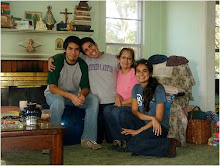 Our Thanksgiving celebration began with a mass organized by Sister Valentine. My friends and i went into the mass a little leery about how long it would be (Pumpkin Pies were in the oven, waiting to be eaten! Mass in Uganda can be 3 hours!--don't judge me too harshly people.) To begin with, we were the only 6 participants, until, in true Ugandan fashion, people began trickling in after it started. Before we arrived at mass, we were asked to write the intentions so to begin mass, Father Edward pulled out the handwritten list, stumbled over my poor handwriting and proceeded to pray for our community in Uganda and America. My friend John, from the east, read the first reading from the Book of the Apocalypse. We listened to tales of the end times and tried to look forward to things to be thankful for. The rest of the Thanksgiving Mass was taken from a 1984 American Prayerbook that Father found somewhere since Ugandan Prayerbooks don't include Thanksgiving. He apologized after mass for the old edition and promised that a newer version was on its way!
Our Thanksgiving celebration began with a mass organized by Sister Valentine. My friends and i went into the mass a little leery about how long it would be (Pumpkin Pies were in the oven, waiting to be eaten! Mass in Uganda can be 3 hours!--don't judge me too harshly people.) To begin with, we were the only 6 participants, until, in true Ugandan fashion, people began trickling in after it started. Before we arrived at mass, we were asked to write the intentions so to begin mass, Father Edward pulled out the handwritten list, stumbled over my poor handwriting and proceeded to pray for our community in Uganda and America. My friend John, from the east, read the first reading from the Book of the Apocalypse. We listened to tales of the end times and tried to look forward to things to be thankful for. The rest of the Thanksgiving Mass was taken from a 1984 American Prayerbook that Father found somewhere since Ugandan Prayerbooks don't include Thanksgiving. He apologized after mass for the old edition and promised that a newer version was on its way!The homily was about how Americans say thank you and Ugandans don't. After mass we found ourselves exclaiming our disagreement! Ugandans do say thank you. They always express their gratitude and appreciation. They just also include a request for more of whatever they received, especially from foreigners. Walking down the village roads, i see moms telling their children to run up to us to ask for money or sweeties. It's something they're taught from childhood, that foreigners have money and they want to share it. It's mostly true. I appreciated Sister Valentine's desire to show her love and support for our American holiday, traditions and our friendships, in ways she knows how to express her committment to friendship, in this instance through a Thanksgiving mass.

For more exciting stories from Thanksgiving 2010, visit: Amanda's Blog









